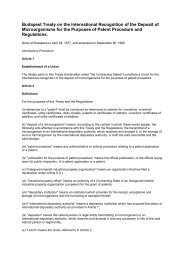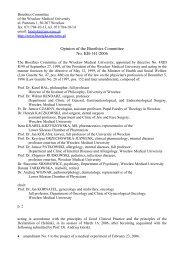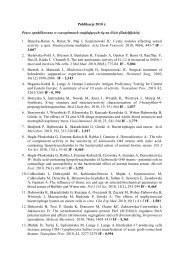Pitfalls in Clinical Research
Pitfalls in Clinical Research
Pitfalls in Clinical Research
Create successful ePaper yourself
Turn your PDF publications into a flip-book with our unique Google optimized e-Paper software.
<strong>Pitfalls</strong> <strong>in</strong> Cl<strong>in</strong>ical <strong>Research</strong><br />
Piotr Zaborowski<br />
Medical University of Warsaw
Cl<strong>in</strong>ical research<br />
means not only<br />
„cl<strong>in</strong>ical trials”<br />
but also<br />
„cl<strong>in</strong>ical behaviour”
The most commonly reported reasons and<br />
justifications of conduct<strong>in</strong>g the research<br />
<strong>in</strong> cl<strong>in</strong>ical environment are:<br />
• patients’ benefit<br />
• improv<strong>in</strong>g the cl<strong>in</strong>ical practice<br />
• ga<strong>in</strong><strong>in</strong>g of experience and knowledge<br />
• progress <strong>in</strong> medic<strong>in</strong>e
On the background of these ideal world<br />
are:<br />
• high impact publications<br />
• popularity and glory<br />
• money<br />
• good relations
Pr<strong>in</strong>ciples of cl<strong>in</strong>ical research<br />
• The basic demand from any research is<br />
bee<strong>in</strong>g ethical. These <strong>in</strong>volves all steps and<br />
phases of the study<br />
• All ethical considerations should be<br />
„patient oriented” (patient benefit,<br />
translational rather than pr<strong>in</strong>ciple based<br />
ethics, valid consent).
Basic rules and basic pitfalls:<br />
1. respect<strong>in</strong>g patient’s rights<br />
2. avoid<strong>in</strong>g research misconduct<br />
- study design and end-po<strong>in</strong>ts<br />
- <strong>in</strong>clusion and exclusion criteria<br />
- randomisation<br />
- data analysis<br />
- publication of the results<br />
- sponsorship
1. PATIENTS’ RIGHTS<br />
• protection of personal autonomy<br />
• to be <strong>in</strong>formed<br />
• access to health care<br />
• appropriate quality of health care<br />
• free choice of caregiver
Pr<strong>in</strong>ciple-based ethics<br />
• beneficence,<br />
• non-maleficence,<br />
• respect for patient's autonomy, and<br />
• justice<br />
("Georgetown mantra")<br />
[Beauchamp RL,Childress JF: Encyclopedia of Bioethics,1995:215-20]
Translational ethics<br />
• autonomy of the patient and<br />
• <strong>in</strong>formed consent<br />
Kagarise MJ, Sheldon G: Arch Surg. 2000;135:39-45.
Autonomy<br />
• self determ<strong>in</strong>ation and<br />
• <strong>in</strong>dependence<br />
(autonomous choices [<strong>in</strong>formed consent,<br />
<strong>in</strong>formed refusal, <strong>in</strong>formed choice] – patient is<br />
expert about his own life and psychosocialspiritual<br />
circumstances; he contributes decision<br />
mak<strong>in</strong>g by express<strong>in</strong>g his personal preferences,<br />
beliefs and values i.e. “personal freedom” and<br />
“freedom of choice”)<br />
• right to privacy and confidentiality<br />
(regard<strong>in</strong>g all health problems)
Legal validity of <strong>in</strong>formed consent<br />
1. patients’ ability to give consent<br />
2. sufficient <strong>in</strong>formation<br />
3. appropriate form of consent
Has the patient also obligations?<br />
• “reasonable patient” standard<br />
• “competent partner – patient”<br />
• (social context of the patients’ rights)
2. Avoid<strong>in</strong>g research misconduct<br />
- study design and end-po<strong>in</strong>ts<br />
(open trials- observer bias; s<strong>in</strong>gle-, double bl<strong>in</strong>d; placebo<br />
controlled; „efficacy and safety”; equivalence and non<strong>in</strong>feriority<br />
trials; mortality, eg. <strong>in</strong>fant mortality as a function<br />
of birth weight disregard<strong>in</strong>g gestational age and fetal<br />
„growth”; costs, eg. cost of the procedure without cost of<br />
complications)<br />
- <strong>in</strong>clusion and exclusion criteria<br />
(pre-study dropouts, eg: exclusion of patients with no<br />
opportunity for follow-up visits; <strong>in</strong>clusion criteria <strong>in</strong>clud<strong>in</strong>g<br />
patients with better prognosis
2. Avoid<strong>in</strong>g research misconduct<br />
- randomisation<br />
(local vs central; cluster randomisation; Zelen’s<br />
prerandomisation design [eligibility, <strong>in</strong>formation, consent,<br />
randomisation] - facilitat<strong>in</strong>g patients’ entry but „mak<strong>in</strong>g”<br />
him defensible <strong>in</strong> the choice of treatment options)<br />
- data analysis<br />
(PP [per protocol], ITT [<strong>in</strong>tention-to-treat], NNT [number<br />
needed to treat])<br />
- publication of the results (researchers or sponsor)<br />
- sponsorship („who w<strong>in</strong>s the reward” - patients,<br />
researcher, „practice”, system, sponsor)
















